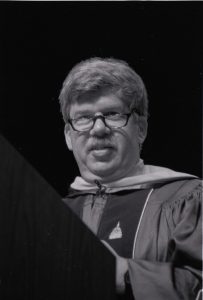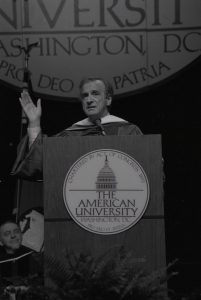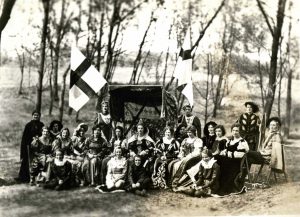AU held its first Homecoming in 1931. This annual event occurred at different times of the year and was scaled back in the 1970s before being updated and improved in 1986. AU’s last Homecoming was in 2003. A new exhibit on the first floor of Bender Library uses photographs and programs to illustrate the history of Homecoming at American University. The exhibit will be on display through the end of the fall semester.
Category Archives: American University History
Fun Facts about Orientation
- The Student Government’s Orientation Board organized a variety of activities including concerts, movies, trips, and barbecues for freshman orientation from the 1940s through 1980.
- In the 1970s and 1980s, the Residence Hall Association provided free ice cream during orientation.
- Summer orientation has been offered regularly since 1980 with the launch of SORC (Summer Orientation Registration Conference). Renamed SOAR (Summer Orientation Advisement and Registration) in 1987, it is now called Eagle Summit. This two day program provides incoming students with an introduction to campus.
- AU’s student newspaper has produced special orientation issues as well as guides to living in Washington, DC.
- The week before classes begin has been called Welcome Week since 1994. One of the regular features of Welcome Week is a performance by the political satire troupe, the Capitol Steps.
- Since 1991, the Freshman Service Experience provides opportunities for community service and an orientation to American University and Washington, D.C. More than 10,000 students have participated in the program since its inception. Students originally worked at local non-profits for four days on the week before the start of classes. The program is currently two days.
Celebrating AU Alumni: Lee Marrs
Special Collections recently acquired a copy of Lee Marrs’ The Further Fattening Adventures of Pudge, Girl Blimp. No. 1. Published by Berkeley based Last Gasp-Eco Funnies in 1973, this is the first of three comics featuring Pudge, an obese virgin from Normal, Illinois, who hitchhikes to San Francisco in her quest to get laid. This collection includes “Pudge in the Case of the Venereal Virgin,” “Pudge in Who Was Dat Self I Saw You With?,” “Pudge in the Fat Rip-Off,” and “Pudge Takes a Trip.”
Lee Marrs graduated from AU with a degree in Fine Art in 1967. She drew comics on social and political themes for AU’s student newspaper, The Eagle. Marrs was one of the original contributors to the Wimmen’s Commix anthology. She started her own animation and computer graphics company in 1972. Marrs has written and drawn both underground and mainstream comics. She worked as an artist on Prince Valiant and author on Wonder Woman.
Summer Programs – Archival History made at American University
American University’s role in the history of archival education is often forgotten. For over twenty-five years, American University co-hosted an Archives Institute along with the National Archives and Records Administration, the Library of Congress and the Maryland State Archives (formerly called the Maryland Hall of Records).
The first course was offered in the summer of 1945. Over the course of three weeks, students listened to lectures on archival theory and practice from archivists at the host institutions. They toured all three facilities and undertook a variety of projects including rehousing, compiling preliminary inventories, cataloging and appraisal.
The Institute’s directors included Ernst Posner and T.R. Schellenberg, early leaders in the field of archival theory. American University’s Archivist, Helen Chatfield, was also on the roster of distinguished lecturers.
American University continues this tradition of summer programs today with offerings from the European Public Affairs and Advocacy Institute, the Nuclear Studies Institute, and the Public Affairs and Advocacy Institute in addition to internships and study-abroad courses.
Campus Growth and Construction
American University’s campus has had four distinct growth periods 1920-1925, 1954-1969, 1985-1987, 2003-present.
Leading up to the opening of the College of Liberal Arts in 1925, AU built a women’s residence hall, library, gymnasium, power plant, and a home for the University President.
The next major construction period began in the mid-1950s and lasted through 1970. During this time the design and feel of AU’s campus was finalized with a central quad surrounded by academic buildings with dormitories and additional academic buildings on the perimeter.
During the 1980s, AU acquired its Tenley Campus and the property adjacent to its recreational center as well as building a new dormitory, Centennial Hall, and Bender Arena.
Since the early 2000s, AU has been modernizing its campus with the construction of the Katzen Art Center, the new School of International Service, its first LEED certified building, and the re-purposing of the Tenley Campus for the Law School and the conversion of the Nebraska Avenue parking lot into much needed dormitory and academic space.
On a side note, a variety of temporary buildings were constructed during World War I and World War II by the War Department. Some of those buildings remained standing until the 2000s.
Commencement Ceremonies
Commencement ceremonies are the culmination of a student’s academic career. This momentous day is shared with family and friends. It is also an opportunity to hear from figures of national importance on topics ranging from career advice to world affairs. AU’s location in Washington, DC makes it possible to for campus to welcome a variety of national and world leaders. Over the years AU students have heard from artists, journalists, judges, politicians and scientists including Marian Anderson, Walter Cronkite, Ruth Bader Ginsburg, Stephen Jay Gould, President John F. Kennedy, and Elie Wiesel.
Until Bender Arena was built, AU held its commencement ceremonies in a variety of campus and off-campus locations including DAR Constitution Hall and the Washington Hebrew Congregation. Starting next academic year, AU will be re-instituting winter commencement. AU held two ceremonies from 1976 through 2003.
May Day at AU in the 1930s and 1940s
One of American University’s earliest traditions was May Day. Based loosely on the English folk celebration, AU students elected a queen, held a pageant, and organized a program of dances. In 1932, the organizers selected an Elizabethan theme.
In 1937 and 1938, a group of men organized their own “Mock May Day” celebration. May Day celebrations were combined with the spring play in 1942 and campus day in 1946. May Day went out of fashion in the 1950s when AU students began electing class queens as well as fraternity “sweethearts.”
Campus Beautification Day
AU will be celebrating its 22nd Campus Beautification Day on April 14th. This university tradition incorporates campus beautification and sustainability goals. Activities include planting, mulching, and installing rain barrels. In 2014, over 4,000 plants were planted on campus and students and staff volunteers participated in a community service project to remove bamboo debris from the Battery-Kemble Trail in Rock Creek Park.
Campus Beautification Day has deep roots at AU. Starting in 1933, AU students and faculty participated in campus cleanup projects in honor of Arbor Day. Classes were cancelled for the day. The morning was spent on a set of designated projects which ended with a picnic lunch. Afternoon activities included softball games and dancing. In addition to landscaping work, students and faculty built rock gardens and wooden bridges and installed benches and railings across campus. By the 1940s, students adopted the name “Campus Day” as the event was no longer always held on Arbor Day. When cleanup activities were held in conjunction with May Day festivities, the winner of the onion pulling contest was named court jester to the court of the spring queen. Campus Day continued through 1957.
April Fools Issues in The Eagle
Between 1964 and 2013, The Eagle featured an April Fools’ issue in each year with the following exceptions: 1970, 1982-1984, 1987, 1989-1992, and 2010. The names of the issues varied from year to year but The Ego, The Beagle, and The Bagel were each used at least twice. Because of the production schedule of The Eagle, the April Fools’ issues were not always released on April 1, with publication dates ranging from March 27 to April 20. Editors played with issue dates as well. For example in 1974, the issue was dated April 1, 1984 while in 1986 the issue was dated March 32, 1986.
The Aprils Fools issues poked fun at campus, local, and national affairs. Some issues had both April Fools and regular content. Here are a few sample headlines: “Dread plague sweeps campus;” “Gone!! Artemas Ward stolen; campus in turmoil;” and “Dewey Defeats Truman.”
AU students have produced a number of humor publications over the years. The original humor magazine was called The Beak. The Archives has a copy of its first and possibly only issue. Its successor, The Bald Eagle, began in 1959 and ran until 1965. The Archives has the complete run.
Celebrating Women’s History at American University
For over fifty years, the AU Women’s Club hosted events ranging from welcome teas for foreign students to fundraisers. Founded in 1930 as the Faculty Woman’s Club, it offered an annual award to a woman student who made an outstanding contribution to life of university. The student’s name was engraved on friendship tray.
The AU Women’s Club membership included faculty and staff and wives of faculty and staff. Starting in 1972, they began awarding a scholarship for a woman student. By the 1980s, they were offering two awards for juniors to use in their senior year.
To learn more about women on campus, visit our exhibit, All About Women: 90 Years of AU History 1893-1983, on display on the first floor of the library.


















